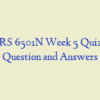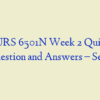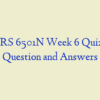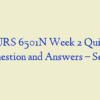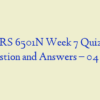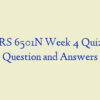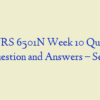Description
NURS 6501N Week 7 QUIZ 4 – Question and Answers
- How should the nurse prepare a patient who is to receive a Schilling test for pernicious anemia?
- A staff member wants to know where the greatest proportion of iron is located. How should the nurse respond? The greatest proportion of total body iron is located in the:
- A 21-year-old female was recently diagnosed with iron deficiency anemia. In addition to fatigue and weakness, which of the following clinical signs and symptoms would she most likely exhibit?
- The people from which country have the lowest risk for Hodgkin lymphoma?
- During an infection, the nurse assesses the lymph nodes. Lymph nodes enlarge and become tender because:
- A nurse monitors for the most common childhood cancer, which is:
- A 35-year-old female is diagnosed with vitamin B12 deficiency anemia (pernicious anemia). How should the nurse respond when the patient asks what causes pernicious anemia? A decrease in ______ is the most likely cause.
- The nurse will check which of the following tests to directly measure iron stores?
- When a nurse is reviewing lab results and notices that the erythrocytes contain an abnormally low concentration of hemoglobin, the nurse calls these erythrocytes:
- A 65-year-old male experienced loss of appetite, weight loss, lemon-yellow skin, liver enlargement, and a beefy red tongue shortly before his death. Autopsy suggested pernicious anemia, and the cause of death would most likely reveal:
- A 5-year-old male was diagnosed with normocytic-normochromic anemia. Which of the following anemias does the nurse suspect the patient has?
- A 10-year-old male presents with abdominal swelling, night sweats, fever, and weight loss. He is diagnosed with Burkitt lymphoma. Upon obtaining the history, which of the following is the most likely cause?
- A 62-year-old female tells her health care provider she has been experiencing regular night sweats that cause her to wake up drenched. She also remarks that she has been unintentionally losing weight. Physical exam reveals enlarged lymph nodes on her neck that do not appear to be painful. She should be screened for which of the following cancers? nurs 6501n week 7
- An adult patient’s blood sample is analyzed in a laboratory. Assuming a normal sample, which type of white blood cell accounts for the highest percentage?
- A 52-year-old male IV drug user was diagnosed with hepatitis C 5 years ago. He is now experiencing impaired blood clotting. The nurse suspects a decrease in which of the following vitamins?
- A newborn baby is diagnosed with a blood disorder in which her platelet count is low. Which of the following does the nurse suspect could be the reason?
- A 15-year-old male is diagnosed with infectious mononucleosis. When the patient asks how he got this disease, how should the nurse respond? The most likely cause is:
- A 45-year-old female undergoes a splenectomy to remove a tumor. Which of the following assessment finding is most likely to occur following surgery?
- After initial compensation, what hemodynamic change should the nurse monitor for in a patient who has a reduction in the number of circulating erythrocytes?
- A 50-year-old female is diagnosed with primary thrombocythemia. A nurse would expect the blood smear to reveal _____ platelets.
- A nurse is teaching the staff about platelets. Which information should the nurse include? In addition to playing a role in hemostasis, platelets have the ability to:
- A 60-year-old female emphysema patient experiences a rapid and pounding heart, dizziness, and fatigue with exertion. Which of the following respiratory assessment findings indicate the respiratory system is compensating for the increased oxygen demand?
- A 25-year-old female has a heavy menses during which she loses a profuse amount of blood. Which of the following adaptations should the nurse expect?
- A newborn is diagnosed with congenital intrinsic factor deficiency. Which of the following types of anemia will the nurse see documented on the chart?
- In disseminated intravascular coagulation (DIC), the nurse assesses for active bleeding after intravascular clotting because:
- Thrombocytopenia may be: nurs 6501n week 7
- A 35-year-old male with hyperthyroidism begins treatment to decrease thyroid activity. A nurse monitors for which of the following conditions that could result secondary to the treatment?
- A 20-year-old female undergoes lab testing for anemia. Results show high iron, bilirubin, and transferrin and low hemoglobin and hematocrit. Which of the following is the most likely diagnosis to be documented on the chart?
- While reviewing lab results, the nurse recalls the most abundant cells in the blood are:
- While checking lab results, the nurse remembers the normal leukocyte count is:
- A 45-year-old male is diagnosed with macrocytic, normochromic anemia. The nurse suspects the most likely cause of this condition is:
- A 5-year-old female is diagnosed with acute leukemia. The nurse will most likely treat this patient with:
- Which major symptom in a patient with sickle cell anemia indicates to the nurse, the patient is experiencing a vaso-occlusive crisis?
- A nurse is caring for a patient who cannot clot. Which end product of the clotting cascade is this patient unable to make?
- A 58-year-old female presents in the clinic presenting with fatigue, weight loss, and tingling in her fingers. Laboratory findings show low hemoglobin and hematocrit, a high mean corpuscular volume, and normal plasma iron. These assessment findings are consistent with which type of anemia?

